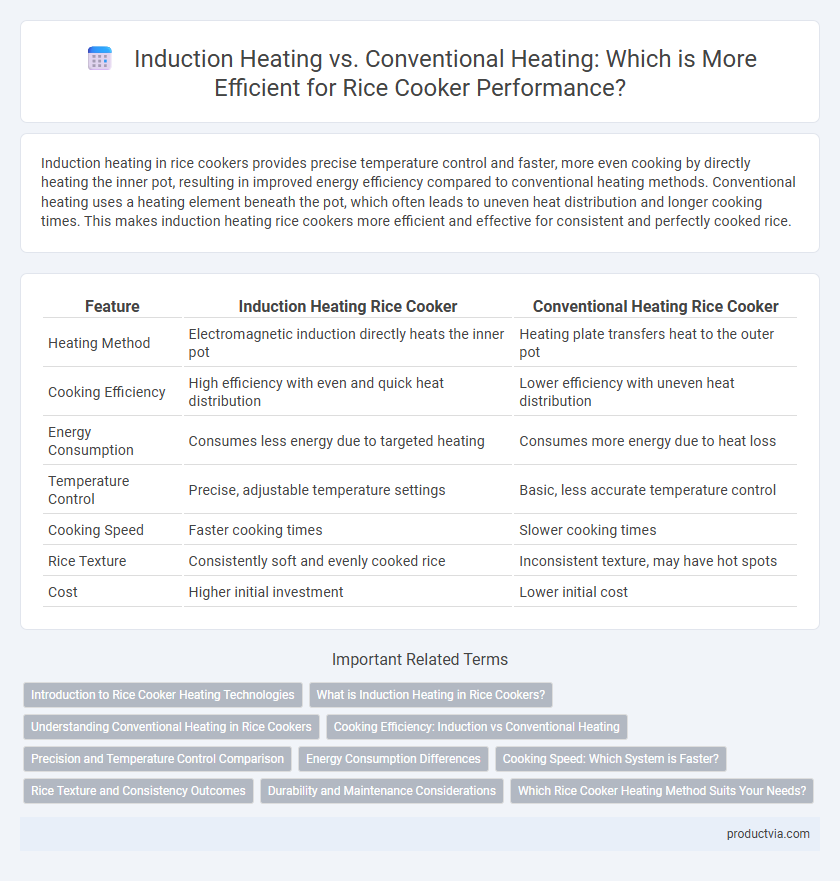Induction heating in rice cookers provides precise temperature control and faster, more even cooking by directly heating the inner pot, resulting in improved energy efficiency compared to conventional heating methods. Conventional heating uses a heating element beneath the pot, which often leads to uneven heat distribution and longer cooking times. This makes induction heating rice cookers more efficient and effective for consistent and perfectly cooked rice.
Table of Comparison
| Feature | Induction Heating Rice Cooker | Conventional Heating Rice Cooker |
|---|---|---|
| Heating Method | Electromagnetic induction directly heats the inner pot | Heating plate transfers heat to the outer pot |
| Cooking Efficiency | High efficiency with even and quick heat distribution | Lower efficiency with uneven heat distribution |
| Energy Consumption | Consumes less energy due to targeted heating | Consumes more energy due to heat loss |
| Temperature Control | Precise, adjustable temperature settings | Basic, less accurate temperature control |
| Cooking Speed | Faster cooking times | Slower cooking times |
| Rice Texture | Consistently soft and evenly cooked rice | Inconsistent texture, may have hot spots |
| Cost | Higher initial investment | Lower initial cost |
Introduction to Rice Cooker Heating Technologies
Induction heating rice cookers utilize electromagnetic fields to heat the cooking pot directly, resulting in faster and more even heat distribution compared to conventional heating methods that apply heat from a metal plate beneath the pot. This technology enhances cooking efficiency by maintaining precise temperature control, reducing energy consumption, and improving the texture and flavor of rice. Conventional heating systems often suffer from uneven heat transfer and longer cooking times, making induction heating a superior choice for advanced rice cookers.
What is Induction Heating in Rice Cookers?
Induction heating in rice cookers uses electromagnetic fields to directly heat the cooking pot, resulting in faster and more even temperature control compared to conventional heating methods that rely on a heating element beneath the pot. This advanced technology improves cooking efficiency by allowing precise temperature adjustments and uniform heat distribution, reducing cooking time and energy consumption. Induction heating rice cookers also enhance the texture and flavor of rice by maintaining optimal heat levels throughout the cooking process.
Understanding Conventional Heating in Rice Cookers
Conventional heating in rice cookers relies on a heating plate that transfers heat directly to the pot, resulting in slower and less uniform cooking compared to induction heating. This method often causes uneven heat distribution, leading to hotspots that can affect rice texture and cooking consistency. Understanding conventional heating is crucial for users seeking budget-friendly rice cookers where precise temperature control and energy efficiency are less of a priority.
Cooking Efficiency: Induction vs Conventional Heating
Induction heating rice cookers deliver superior cooking efficiency by utilizing electromagnetic fields that heat the pot directly, resulting in faster and more even temperature distribution compared to conventional heating elements. Conventional heating relies on a heating plate that transfers heat from the bottom, often causing uneven cooking and longer cooking times. Energy consumption in induction cookers is lower, making them more efficient for consistent rice texture and precise temperature control.
Precision and Temperature Control Comparison
Induction heating in rice cookers offers superior precision and temperature control compared to conventional heating methods, utilizing electromagnetic fields to directly heat the pot for even and responsive cooking. Conventional heating relies on external heat sources that often result in uneven temperature distribution and slower response times, impacting cooking consistency. The precise temperature regulation of induction technology enables optimal starch gelatinization and texture, improving overall rice quality and energy efficiency.
Energy Consumption Differences
Induction heating rice cookers utilize electromagnetic fields to directly heat the inner pot, resulting in faster and more precise temperature control with significantly lower energy consumption compared to conventional heating methods that rely on thermal conduction from a heating plate. Studies show induction heating can reduce energy usage by up to 30%, translating to cost savings and improved environmental impact while maintaining consistent cooking quality. Conventional rice cookers often experience heat loss and slower temperature adjustment, leading to higher overall electricity consumption during cooking cycles.
Cooking Speed: Which System is Faster?
Induction heating in rice cookers offers significantly faster cooking speeds compared to conventional heating due to its ability to directly and evenly heat the inner pot through electromagnetic fields. Conventional heating relies on indirect heat transfer from a heating plate, leading to slower temperature rise and longer cooking times. The precise temperature control of induction heating ensures efficient energy use and quicker completion of cooking cycles.
Rice Texture and Consistency Outcomes
Induction heating rice cookers deliver superior heat distribution and precise temperature control, resulting in evenly cooked rice with optimal texture and enhanced consistency. Conventional heating relies on a single heat source, often causing uneven cooking and variable rice moisture. The consistent magnetic heating in induction models prevents overcooking or undercooking, producing fluffy, perfectly textured rice every time.
Durability and Maintenance Considerations
Induction heating rice cookers offer superior durability due to their robust internal components and precise temperature control, reducing wear and tear over time. Conventional heating models often experience uneven heat distribution, leading to faster degradation and more frequent maintenance needs. Choosing induction heating can minimize long-term maintenance costs and extend the lifespan of the rice cooker significantly.
Which Rice Cooker Heating Method Suits Your Needs?
Induction heating rice cookers offer precise temperature control and faster, more even cooking by using electromagnetic fields to heat the entire inner pot directly, enhancing energy efficiency and cooking consistency. Conventional heating rice cookers rely on a heating element beneath the pot, which can result in slower heat distribution and potential hot spots, affecting cooking performance. Choosing between induction and conventional heating depends on your priorities for cooking speed, fuel efficiency, and budget, with induction models generally suiting users seeking advanced technology and optimal cooking results.
Induction Heating vs Conventional Heating for cooking efficiency Infographic

 productvia.com
productvia.com